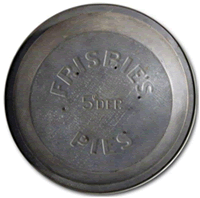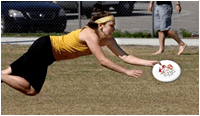The Birth of the Frisbee

The History of Ultimate Frisbee begins with the invention of the Frisbee, aka, the disc. The origins of the Frisbee begin over one hundred years ago with the Frisbie Baking Company in the small town of Bridgeport, Connecticut. The Frisbie Baking Company was the purveyor of delicious pies.
The founder of the Frisbie Baking Company was William Frisbie, and he had a unique “spin” on marketing his pies. These pies were sold in light, metal tins emblazoned with the logo of the Frisbie Baking Company.
Employees and customers alike soon found
out they had some special properties. These tins were remarkably adept at something other than holding pies. Workers began tossing these pie tins around the factory floor, and then around the factory grounds and during their free time away from work.
Eventually tossing the discs around became very popular at many of the colleges and universities in New England which marks the beginning of the sport of Ultimate Frisbie. The Frisbie pie tin is the ancestor of today’s modern Frisbee or Disc.
The Development of the Frisbee

The father of the modern Frisbee is Walter Frederick Morrison. He was the first modern producer and inventor of Frisbees. The development of the modern Frisbee begins on a beach in Santa Monica in 1938. On that day Mr. Morrison and his future wife Lucile were tossing a pie pan back and forth on the beach.
Bystanders began to take notice and soon after someone approached Walter and Lucile and offered to pay 25 cents for the tin. Since he had only paid 5 cents for the pie tin he gladly accepted and an idea dawned on him for a new product, a disc that could be produced cheaply and sold as a sporting good or recreational device.
As Morrison puts it, “That got the wheels turning, because you could buy a cake pan for 5 cents, and if people on the beach were willing to pay a quarter for it, well, there was a business.” (1) Walter Morrison and his wife began purchasing pie pans in bulk and selling them on the beach for 25 cents, making a sizable profit on each sale. This business continued until the onset of World War II, when Morrison joined the United States Air Force.
Following his military service in 1946, Frederick began mulling a design for a lightweight plastic version of the pie tins he sold on the beach in Santa Monica. After experimenting with different models and taking on a creative partner named Warren Franscioni he settled on one design in 1948 and called it the “Whirl-O-Way”.
After the UFO craze of the late forties hit the country they decided to change the name from Whirl-O-Way to the “Flying Saucer” to capitalize on the mania. After almost a decade in business Morrison eventually sold his idea in 1957 to the Wham-O Toy Corporation. The Wham O Company decided to rename the discs after their first inventor, William Frisbie, and the modern Frisbee was born.
The Beginning of Disc Sports
After the creation of the modern Frisbee, it did not take long for people to start developing organized sports around the new device. There is debate as to where and when the history of Ultimate begins but many sources trace the roots of modern Ultimate to early “Frisbee Football” games.

In the 1960s, as numbers of young people became alienated from social norms, they resisted and looked for alternatives. They formed what became known as the counterculture. The Frisbee represented a unique form of recreation and an alternative to the “establishment” ball sports. The IFA Newsletter made its debut in 1968 and brought together previously isolated and undocumented pockets of disc play. Stories of Frisbee activities, including stories about people who could throw a Frisbee in different ways and could make fancy trick catches began to circulate. Freestyle, along with Frisbee’s first sport, Frisbee guts, was the first Frisbee events to demonstrate the athletic possibilities of using the flying disc in sports.
There were a few guts and distance events before 1970 but organized competitive disc sports, began in the early 1970s, with promotional efforts from Wham-O and Irwin Toy (Canada), a few tournaments and professionals using Frisbee show tours to perform at universities, fairs, and sporting events. Through the IFA Newsletter, the Frisbee community found out about the International Frisbee Tournament (IFT), upper peninsula MI, Canadian Open Frisbee Championship in Toronto, On, American Flying Disc Open in Rochester, NY, The Octad, New Brunswick, NJ and the World Frisbee Disc Championships, Rose Bowl, Pasadena, CA. These were the first tournaments to threat the Frisbee as more than a toy and was the beginning competitions for all the disc sports. Disc sports such as freestyle, double disc court, guts, ultimate and disc golf became this sport’s first events. Two sports, the team sport of ultimate and disc golf are very popular worldwide and are now being played semi-professionally. The World Flying Disc Federation, Professional Disc Golf Association, Freestyle Players Association are the official rules and sanctioning organizations for flying disc sports worldwide.
A Brief History of the Creation and Development of Ultimate
In 1966-67, Jared Kass and fellow students play a team frisbee game at Amherst College, Mass. A team Frisbee game based on concepts from American football, basketball, and soccer. This game had some of the basics of modern ultimate including scoring by passing over a goal line, advancing the disc by passing, no travelling with the disc, and turnovers on interception or incomplete pass. Jared Kass, an instructor, taught this game to high school student Joel Silver during the summer of 1967- 68 at Mount Hermon Prep school summer camp. Joel Silver, along with fellow students, Jonny Hines, Buzzy Hellring, further developed ultimate beginning in 1968 at Columbia High School, Maplewood, New Jersey, (CHS). The first sanctioned game was played at CHS in 1968 between the student council and the student newspaper staff. Beginning the following year evening games were played in the lights on the school’s student-designated parking lot. Silver, Hellring and Hines developed the first and second edition of “Rules of Ultimate Frisbee”. In 1970 CHS defeated Millburn High 43-10 in the first interscholastic ultimate game. CHS, Millburn, and three other New Jersey high schools made up the first conference of Ultimate teams beginning in 1971.
On the collegiate level, the first Ultimate game was played by the same two universities who played the very first intercollegiate football game. On November 6th, 1972 Rutgers defeated Princeton 29 to 27. Interestingly, Rutgers had also won the first football match 103 years earlier on the same field by the same 2 point margin.
Beginning In 1975, ultimate was included as an exhibition at major overall (multiple event) Frisbee tournaments, including the World Frisbee Championships in California, The Octad in New Jersey, American Flying Disc Open (AFDO) in New York and the Canadian Open Frisbee Championships in Toronto. This was the beginning of introducing ultimate Frisbee in the way of demonstrations added to the tournament events at the biggest Frisbee tournaments of that time.
Modern Ultimate rules differ significantly from the early rules at Columbia High School. The modern game shares many similarities with the original versions of the game but is more polished and regulated.
Ultimate is played and regulated primarily by two organizations, the American Ultimate Disc League and USA Ultimate. Internationally, The World Flying Disc Federation provides direction on Ultimate Rules and Events.